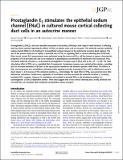Files in this item
Prostaglandin E2 stimulates the epithelial sodium channel (ENaC) in cultured mouse cortical collecting duct cells in an autocrine manner
Item metadata
| dc.contributor.author | Mansley, Morag K. | |
| dc.contributor.author | Niklas, Christian | |
| dc.contributor.author | Nacken, Regina | |
| dc.contributor.author | Mandery, Kathrin | |
| dc.contributor.author | Glaeser, Hartmut | |
| dc.contributor.author | Fromm, Martin F. | |
| dc.contributor.author | Korbmacher, Christoph | |
| dc.contributor.author | Bertog, Marko | |
| dc.date.accessioned | 2020-07-09T15:30:01Z | |
| dc.date.available | 2020-07-09T15:30:01Z | |
| dc.date.issued | 2020-05-22 | |
| dc.identifier | 268897254 | |
| dc.identifier | f0b90d1a-e116-45bd-ba4d-4eb5495b0988 | |
| dc.identifier | 85085538055 | |
| dc.identifier | 32442241 | |
| dc.identifier.citation | Mansley , M K , Niklas , C , Nacken , R , Mandery , K , Glaeser , H , Fromm , M F , Korbmacher , C & Bertog , M 2020 , ' Prostaglandin E 2 stimulates the epithelial sodium channel (ENaC) in cultured mouse cortical collecting duct cells in an autocrine manner ' , Journal of General Physiology , vol. 152 , no. 8 , e201912525 . https://doi.org/10.1085/jgp.201912525 | en |
| dc.identifier.issn | 0022-1295 | |
| dc.identifier.other | ORCID: /0000-0002-8082-0273/work/143917387 | |
| dc.identifier.uri | https://hdl.handle.net/10023/20227 | |
| dc.description | Funding: This study was supported by the Deutsche Forschungsgemeinschaft (DFG, German Research Foundation), project number 387509280, SFB 1350), the Alexander von Humboldt Foundation (3.3-GRO/1143730 STP), the Interdisziplin ̈ares Zentrum für KlinischeForschung of Friedrich-Alexander University (IZKF, TP-A33), and the Bayerische Forschungsstiftung (PDOK-74-10). | en |
| dc.description.abstract | Prostaglandin E2 (PGE2) is the most abundant prostanoid in the kidney, affecting a wide range of renal functions. Conflicting data have been reported regarding the effects of PGE2 on tubular water and ion transport. The amiloride-sensitive epithelial sodium channel (ENaC) is rate limiting for transepithelial sodium transport in the aldosterone-sensitive distal nephron. The aim of the present study was to explore a potential role of PGE2 in regulating ENaC in cortical collecting duct (CCD) cells. Short-circuit current (ISC) measurements were performed using the murine mCCDcl1 cell line known to express characteristic properties of CCD principal cells and to be responsive to physiological concentrations of aldosterone and vasopressin. PGE2 stimulated amiloride-sensitive ISC via basolateral prostaglandin E receptors type 4 (EP4) with an EC50 of ∼7.1 nM. The rapid stimulatory effect of PGE2 on ISC resembled that of vasopressin. A maximum response was reached within minutes, coinciding with an increased abundance of β-ENaC at the apical plasma membrane and elevated cytosolic cAMP levels. The effects of PGE2 and vasopressin were nonadditive, indicating similar signaling cascades. Exposing mCCDcl1 cells to aldosterone caused a much slower (∼2 h) increase of the amiloride-sensitive ISC. Interestingly, the rapid effect of PGE2 was preserved even after aldosterone stimulation. Furthermore, application of arachidonic acid also increased the amiloride-sensitive ISC involving basolateral EP4 receptors. Exposure to arachidonic acid resulted in elevated PGE2 in the basolateral medium in a cyclooxygenase 1 (COX-1)-dependent manner. These data suggest that in the cortical collecting duct, locally produced and secreted PGE2 can stimulate ENaC-mediated transepithelial sodium transport. | |
| dc.format.extent | 15 | |
| dc.format.extent | 2122209 | |
| dc.language.iso | eng | |
| dc.relation.ispartof | Journal of General Physiology | en |
| dc.subject | QH301 Biology | en |
| dc.subject | QP Physiology | en |
| dc.subject | Physiology | en |
| dc.subject | 3rd-NDAS | en |
| dc.subject.lcc | QH301 | en |
| dc.subject.lcc | QP | en |
| dc.title | Prostaglandin E2 stimulates the epithelial sodium channel (ENaC) in cultured mouse cortical collecting duct cells in an autocrine manner | en |
| dc.type | Journal article | en |
| dc.contributor.institution | University of St Andrews. School of Medicine | en |
| dc.contributor.institution | University of St Andrews. Centre for Biophotonics | en |
| dc.contributor.institution | University of St Andrews. Cellular Medicine Division | en |
| dc.contributor.institution | University of St Andrews. Biomedical Sciences Research Complex | en |
| dc.identifier.doi | https://doi.org/10.1085/jgp.201912525 | |
| dc.description.status | Peer reviewed | en |
| dc.identifier.url | https://rupress.org/jgp/article/152/8/e201912525/151804/Prostaglandin-E2-stimulates-the-epithelial-sodium | en |
This item appears in the following Collection(s)
Items in the St Andrews Research Repository are protected by copyright, with all rights reserved, unless otherwise indicated.

